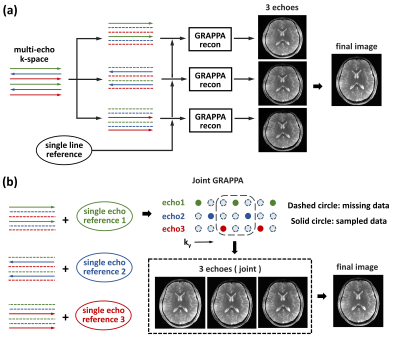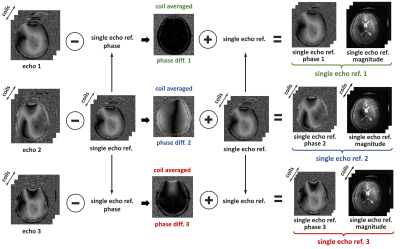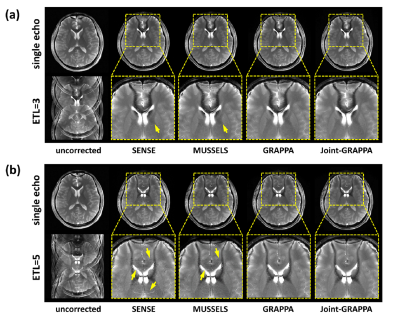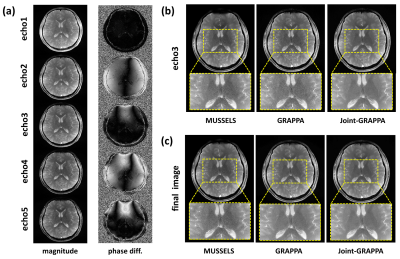3875
Robust Nyquist Ghost Correction for Multi-echo Balanced SSFP at 7T Using Joint-GRAPPA1Center for Biomedical Imaging Research, Department of Biomedical Engineering, School of Medicine, Tsinghua University, Beijing, China, 2State Key Laboratory of Brain and Cognitive Science, Beijing MRI Center for Brain Research, Institute of Biophysics, Chinese Academy of Sciences, Beijing, China, 3University of Chinese Academy of Sciences, Beijing, China, 4Laboratory of FMRI Technology (LOFT), Stevens Neuroimaging and Informatics Institute, University of Southern California, Los Angeles, CA, United States, 5Beijing Institute for Brain Disorders, Beijing, China
Synopsis
Multiline bSSFP is an acceleration technique that has the potential to approach the speed of EPI while overcoming inherent EPI artifacts in fMRI. However, the highly segmented EPI readout in multiline bSSFP can cause severe Nyquist artifacts. Additionally, extra magnitude and phase differences among the echoes also exist within the echo train, making it more complicated. In this study, a joint-GRAPPA based 2D phase correction method is proposed, which can robustly correct artifacts in multi-echo bSSFP with different ETLs while maintaining the image SNR. To evaluate its performance, this approach is also compared to other parallel imaging based correction methods.
Introduction
To accelerate acquisition of balanced steady-state free precession (bSSFP), multiline bSSFP, which employs a highly segmented EPI readout with a interleaved phase-encoding order, has recently been proposed1. It can approach the speed of echo-planar imaging (EPI) and show an increased BOLD sensitivity in fMRI. In addition, it is immune to artifacts like signal dropouts and image distortions2 commonly seen in gradient-echo EPI images, especially at ultrahigh magnetic fields like 7T. However, in highly segmented EPI, alternating the readout polarity causes misalignment of the k-space lines due to eddy current, field inhomogeneity and other hardware imperfections3, producing severe ghost artifacts in multi-echo bSSFP with a sequential phase-encoding order, as shown in Fig. 1c.Unlike conventional EPI, multi-echo bSSFP with odd echo train length (ETL) has identical readout polarities at the segment edges in k-space. For example, when ETL = 3, the 3rd echo of the first echo train and the 1st echo of the second echo train are both positive readout, as seen in Fig. 1b. Thus this leads to N/ETL shift aliasing artifacts. Furthermore, multi-echo bSSFP introduces extra magnitude difference and phase errors within the echoes for each excitation. When data are combined together for final image output, the signal difference makes linear phase correction (LPC) methods and 2D phase correction methods (such as PEC-SENSE3) unsuitable.
By estimating 2D phase difference maps and incorporating them into auto-calibration signals (ACS), we propose a joint-GRAPPA4 based ghost correction method to correct for the aliasing artifacts in sequential multiline or multi-echo bSSFP. It can also preserve image signal-to-noise ratio (SNR), especially when ETL is large.
Methods
Data acquisitionExperiments were conducted on a 7T MRI scanner (Siemens, Erlangen, Germany) with a volume transmit/32-channel receive head coil. Both multi-echo bSSFP and multi-echo integrated SSFP2 (iSSFP) sequence (a recently proposed method that can overcome susceptibility artifacts of bSSFP) were performed on a healthy subject using three different ETLs (ETL 1/3/5) with the following acquisition parameters: TR =3.94/7.0/10.2ms , TE = 1.97/3.5/5.1 ms, slice-acquisition time=864/574/542 ms, field of view = 200 x 200 x 3 mm3, resolution = 1 x 1 x 3 mm3, flip angle = 35°.
Reconstruction
Basic GRAPPA is used for reconstruction as shown in Fig. 2a. 1) The multi-echo k-space data are separated into different groups based on their echo order within a TR, and the missing data are filled with zeros. 2) Using the central part of the single echo k-space data (ETL=1) as the ACS lines, GRAPPA generates a set of ghost-free images $$$I_{i}(x,y),\ i=1,2,\cdot\cdot\cdot,ETL$$$ recovered from different echoes, respectively. 3) A final image can be obtained by simply averaging the recovered set of images. However, this basic GRAPPA based method still suffers from image SNR decrease attributed to noise amplification during parallel imaging reconstruction3, especially for a high ETL factor.
In Fig. 2b, we demonstrate a joint-GRAPPA based ghost correction method to further preserve image SNR. For joint-GRAPPA, a set of ACS data are first calculated to match the phase of the multiple echoes. As seen in Fig. 3, 2D phase difference maps between the GRAPPA recovered images and the single echo images are first calculated as $$$\triangle\varphi_{i}(x,y)=Arg\left[\ I_{i}(x,y)\ I^{*}_{ETL=1}(x,y)\ \right]$$$. They are then incorporated into the single echo ACS data to generate a set of phase-matched ACS data for the separated k-space groups of different echoes. Notice that phase difference added to the single echo reference should be the same across channels. Thus, joint-GRAPPA can recover the missing data jointly using different echo data together. As illustrated in Fig. 2b, the k space sampling is staggered, and joint-GRAPPA fits kernels across the 3 different echoes.
Similarly, sensitivity encoding (SENSE) based correction methods are also implemented for comparison, applying single echo data to obtain coil sensitivity maps. SENSE can be easily accomplished, but the joint-SENSE reconstruction, PEC-SENSE3, cannot be directly implemented due to the magnitude difference of the images $$$I_{echo=i}(x,y) $$$. Instead, MUSSELS5, a method for the recovery of multi-shot diffusion weighted images, is adopted. The multi-shot DWI images with motion-induced phase difference are replaced by the multi-echo bSSFP images with EPI-induced phase difference here. The low-rank matrix is obtained from the separate groups with different echoes jointly.
Results and Discussion
Fig. 4 demonstrates the ghost corrected multi-echo bSSFP images, with ELT = 3 and 5. Residual aliasing artifacts are observed on the SENSE-based reconstruction, but are well corrected using GRAPPA and joint-GRAPPA.Fig. 5 demonstrates the ghost corrected multi-echo iSSFP images with ETL=5. It is observed in Fig. 5a that EPI acquired k-space data introduce both magnitude differences and phase difference, even with the same readout polarity (e.g. echo1, 3, 5), as mentioned in the introduction. Fig. 5 b and c show that the proposed joint-GRAPPA method can preserve the image SNR when ETL is large, both for the one-echo and averaged images. GRAPPA, however, obtains noisy one-echo images.
Conclusion
A robust ghost correction method incorporating 2D phase difference maps with joint-GRAPPA is proposed for multil-echo bSSFP and iSSFP at 7T. This approach is reliable for different ETLs and demonstrates better SNR performance over other parallel imaging based ghost correction methods. fMRI results can be found in another abstract from our team.Acknowledgements
This work was supported by the National Nature Science Foundation of China grants (81871350, 31730039).References
1. Ehses P, Scheffler K. Multiline balanced SSFP for rapid functional imaging at ultrahigh field. Magn Reson Med 2018;79(2):994-1000.
2. Sun KB, Xue R, Zhang P, et al. Integrated SSFP for functional brain mapping at 7 T with reduced susceptibility artifact. J Magn Reson 2017;276:22-30.
3. Xie VB, Lyu MY, Liu YL, Feng YQ, Wu EX. Robust EPI Nyquist ghost removal by incorporating phase error correction with sensitivity encoding (PEC-SENSE). Magn Reson Med 2018;79(2):943-951.
4. Bilgic B, Kim TH, Liao C, et al. Improving parallel imaging by jointly reconstructing multi-contrast data. Magn Reson Med 2018;80(2):619-632.
5. Mani M, Jacob M, Kelley D, Magnotta V. Multi-shot sensitivity-encoded diffusion data recovery using structured low-rank matrix completion (MUSSELS). Magn Reson Med 2017;78(2):494-507.
Figures




